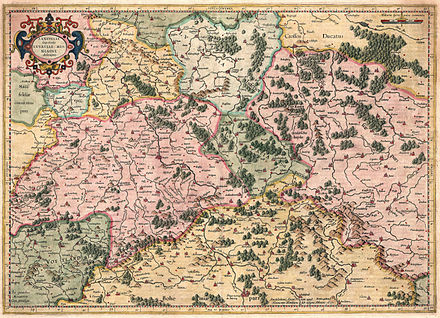Via Regia Lusatiae Superioris
The Hohe Landstrasse (also the Army or Salt Road) lat . via regia Lusatiae superioris , or strata regia , was a trade route and is one of the old routes . It was part of the Via Regia , which led west to the Rhine .
For several centuries the road was the most important traffic connection from Central Germany to Silesia and the Polish East, along with the Niederstraße running north. Like other imperial roads , it was under special peace protection. The Via Regia was also important as the Way of St. James .
course
It led through Upper Lusatia , from Halle (Saale) via Eilenburg or Leipzig - Grimma to Oschatz , Großenhain , Königsbrück , Kamenz , Bautzen , Löbau , Görlitz or Zittau , Lauban , Naumburg , Bunzlau , Haynau , Liegnitz , Neumarkt to Breslau . It had continuations east to Krakau and west of Leipzig, or Halle through Thuringia to Frankfurt am Main .
term
The Latin name strata regia ('royal road') is attested to 1252, antiqua strata ('old road') it was mentioned in 1241 in the Upper Lusatian border document . As Via Regia ('Königsstraße' or 'Königsweg') the road lost its royal function in 1307 after the battle of Lucka and was now placed under the supervision of the respective sovereigns.
The German name Hohe Straße has only been in use since the beginning of the 16th century. In contrast to the Niederstraße (Via Regia Lusatiae Inferioris) running to the north, Hohe Straße means the preferred street with special privileges. Presumably it was not until 1732 that the respondent at the Wittenberg University and later professor at the Knight's Academy in Lüneburg, Johann Friedrich Schwartz, coined the term via regia Lusatiae superioris (Königsstrasse in Upper Lusatia).
history
The main features of the road already existed in prehistoric times. The Via Regia Lusatiae Superioris had its first heyday from around 1200 when Wroclaw was supplied with salt from Halle.
Through agreements between Georg von Podiebrad as king of Bohemia and sovereign of Silesia, the Upper Lusatian Union of Six Cities and the Elector of Saxony as sovereign of Leipzig around 1460, the Hohe Landstrasse was given the character of a forced road for all traffic between Poland / Silesia and Leipzig. According to this, all carters and merchants should use the Hohe Landstrasse if they touched the Queis , a left tributary of the Bober , on their way (so stir the Queis) . This was intended to secure the customs income of the neighboring lordships and cities.
The route over the Hohe Landstrasse was associated with considerable costs for travelers in terms of customs duties, escort money or excessive accommodation costs in inns. Therefore, one tried again and again to switch to other routes such as Niederstrasse. In addition, the Breslau stacking rights and miles privilege repeatedly led to complaints from the Saxon side. With the market and stacking rights of the city of Leipzig, the traffic frequency on the two streets increased. In the 19th century in particular, traders moved west with their white elephants (large covered wagons covered with linen) and sold hides, linen and other natural goods at large markets such as the Brühl in Leipzig . Conversely, for example, salt was traded to the east.
In Grossenhain, the Hohe Strasse crossed the north-south trade route that led from the Baltic Sea through the Mark Brandenburg via Saxony to Bohemia (see Kulmer Steig ). The safe use of the Hohen Strasse within the Mark Meissen was regulated in contracts (1399, 1404), and was bought with customs duties that were levied in Grossenhain.
literature
- Alexander Tille : The beginnings of the Hohen Landstrasse. Gotha 1908.
- Winfried Müller , Swen Steinberg (Hrsg.): People on the move - via regia and its actors. Volume of essays on the 3rd Saxon State Exhibition. Sandstein Verlag, Dresden 2011.
- Thomas Nitschke : I'd rather stay here - On the Way of St. James through Saxony , traveldiary Verlag, Hamburg 2013, ISBN 978-3-941796-99-7 .
Web links
- VIA REGIA meeting room - Landesverband Sachsen e. V.
- VIA REGIA - Culture Route of the Council of Europe , European Culture and Information Center in Thuringia
- Via Regia - 800 years of movement and encounter ( Memento from May 3, 2010 in the Internet Archive ), 3rd Saxon State Exhibition from May 21 to October 31, 2011 in the Kaisertrutz in Görlitz
Individual evidence
- ↑ Hohe Landstrasse . In: Meyers Großes Konversations-Lexikon . 6th edition. tape 9 . Bibliographisches Institut, Leipzig 1907, p. 441 ( online ).
- ^ Johann Friedrich Schwartz: Viam Regiam Lusatiae Superioris . Wittenberg 1732 ( digitized version ).
- ^ Christian Adolf Pescheck : History of industry and trade in Upper Lusatia . In: New Lusatian Magazine . tape 29 , 1852, pp. 221 ff . ( Full text in Google Book Search).
- ^ Friedrich Christoph Jonathan Fischer: History of the German trade . Helwingsche Hofbuchhandlung, Hanover 1792, p. 98 ff . ( Full text in Google Book Search).
- ^ Dietrich Hanspach, Haik Thomas Porada: Grossenhainer care. A regional study in the Grossenhain and Radeburg area . Böhlau Verlag, Cologne / Weimar / Vienna 2008, ISBN 978-3-412-09706-6 , p. 1 ( limited preview in Google Book search).

